and Andrea Bischoff1
(1)
Pediatric Surgery, Colorectal Center for Children Cincinnati Children’s Hospital, Cincinnati, OH, USA
Electronic supplementary material
Supplementary material is available in the online version of this chapter at 10.1007/978-3-319-14989-9_6.
6.1 Introduction
Advances in imaging technology have been extremely beneficial for the management of patients with anorectal malformations. Every day, we learn about technologic innovations that frequently surpass our imagination. Concurrently with these, the surgeons have to speculate less and less, like in the past [1], and have the privilege of making very precise anatomic diagnosis that allows the planning of a complex reconstruction in a very accurate manner.
In dealing with the spectrum of anorectal malformations, we depend very much on the images obtained by traditional x-rays, ultrasound, CAT scan, and magnetic resonance imaging (MRI). We use all of these images not only in the early stages of our management but actually through the entire life of the patient, since each stage of life of the patient brings new therapeutic challenges that require an accurate diagnosis.
6.2 Prenatal Diagnosis
Every year, more and more, the pediatric surgeon is asked to participate in the diagnostic discussions of babies in utero that have congenital malformations. The reader is invited to read Chap. 3.
6.3 Neonatal Imaging
The first 24 h of life, before making the decision to open a colostomy or to perform a primary repair, represents a window of opportunity to diagnose potential associated defects. The chest film taken during the first 24 h of life also allows us to see the integrity of the thoracic vertebra and ribs. In addition, it helps us in the diagnosis of esophageal atresia and potential cardiac malformations (Fig. 6.1).
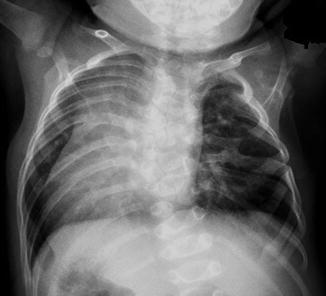

Fig. 6.1
Chest film of a child with anorectal malformation associated to thoracic hemivertebrae and esophageal atresia
The abdominal x-ray film allows us to see and rule out the possibility of hemivertebra (Fig. 6.2). The early detection of these types of malformations is relevant to establish the functional prognosis in these babies. The abdominal film must include an AP view of the sacrum (Fig. 6.3). It is also important to take a lateral abdominal film that allows a more accurate measurement of the sacral ratio (Figs. 6.3 and 6.4).
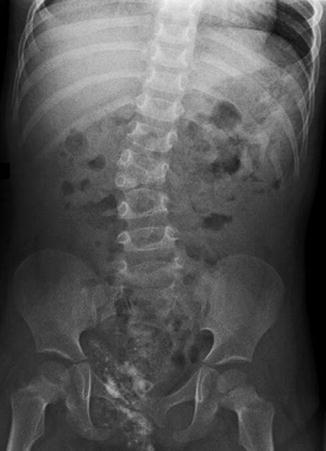

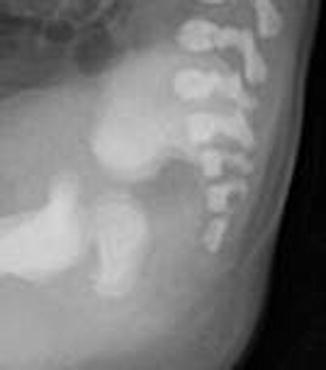

Fig. 6.2
Abdominal film showing a hemivertebrae

Fig. 6.3
AP film of sacrum in a child with anorectal malformation. (a) Normal sacrum. (b) Short sacrum. (c) Severely deficient. (d) Caudal regression. (e) Hemisacrum

Fig. 6.4
Lateral film of sacrum
Traditionally, the number of sacral vertebrae is counted to evaluate the quality of the sacrum. Most pediatric surgeons agree that when a patient has less than three sacral vertebrae, the prognosis for bowel and urinary control is not good. Many others while discussing the subject of the sacrum use rather nondescriptive terms such as “dysplastic” or “hypoplastic.” There is no question that the presence of the sacrum as well as its integrity is crucial to determine the functional prognosis of the patient.
We found the terms “dysplastic” or “hypoplastic” very inaccurate. In addition, we found that there are cases with five sacral vertebrae, yet very abnormal ones, which results in an extremely short sacrum associated to fecal and sometimes urinary incontinence. We thought that it was necessary to create a more objective way to evaluate the sacrum, in an effort to determine the functional prognosis of the baby. The result was the creation of the “sacral ratio” (Fig. 4.5 in Chap. 4), [2, 3].
The sacral ratio results from comparing the vertical length of the sacrum with the size of the pelvis of the same patient.
A.
A line is drawn between the most upper portions of the iliac bone in an AP film of the sacrum.
B.
C.
A third line is drawn, parallel to the first two lines, touching the lowest radiologically visible point of the sacrum or coccyx.
The distance between lines A and B is measured, as well as the distance between lines B and C. A ratio is created: AB/BC.
We measured this ratio in 100 normal children who had abdominal films taken for other reasons and found that the average ratio in anterior-posterior films was 0.76 and 0.77 in lateral films [2]. Patients with anorectal malformations frequently suffer from different degrees and types of sacral abnormalities. The sacral abnormalities present like a spectrum with ratios similar to normal children, in what we call the good side of the spectrum. However, in the “bad” extreme of the spectrum, we see patients with a sacral ratio of 0.
We found that it is extremely unusual for a patient with anorectal malformation and with a ratio lower than 0.4 to have bowel control. To have a normal sacral ratio is a good prognostic sign, but it does not mean that the patient will necessary have bowel control, since there are other factors that influence the final functional results.
One of the relatively common associated defects in children with anorectal malformations are defects of the radial bone (Fig. 6.5). Sometimes, the defect in the forearms and the hands is very obvious (Fig. 6.5a). Other times, one can see only a slight radial deviation of the hand that would make us suspect this defect.
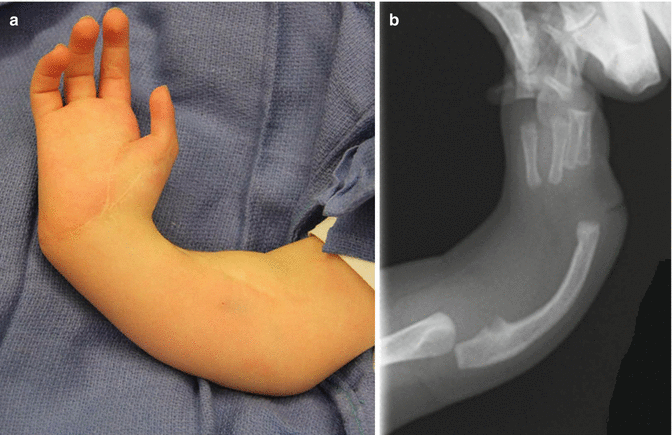

Fig. 6.5
Absent radial bone – a frequently associated defect. (a) External appearance. (b) Radiologic appearance
An ultrasound study is also part of the group of imaging studies that must be done during the first 24 h of life before the baby suffers from abdominal distention. The kidney ultrasound is perhaps the most important part of the evaluation of this baby since about 50 % of them, globally, have some sort of urologic-associated condition. We specifically look for hydronephrosis (Fig. 6.6). One of the most common urologic anatomic defects is absent or multicystic kidney (Fig. 6.7). The ultrasound must include the rest of the abdomen looking for the presence of megaureters and the bladder. This is particularly useful and important in female babies with a single perineal orifice (cloaca). In these babies, we will specifically look for the presence of a cystic structure located behind the bladder (hydrocolpos). Frequently, this is a double cystic structure since about 30 % of the babies with cloaca have two hemivaginas (Fig. 6.8).

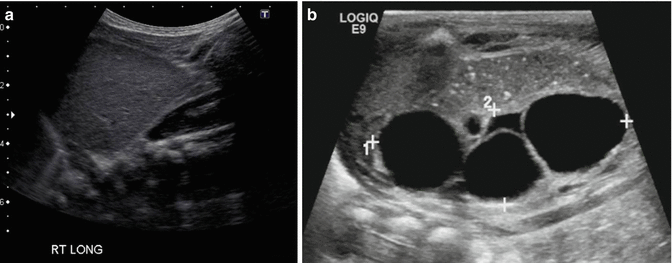


Fig. 6.6
Neonatal ultrasound. (a) Normal. (b) Hydronephrosis

Fig. 6.7
Ultrasound. (a) Absent kidney. (b) Multicystic kidney

Fig. 6.8
Neonatal hydrocolpos in a newborn baby with hydronephrosis. (a) Ultrasound. V vagina, K kidney. (b) Abdominal film. V vagina, R rectum. (c) MRI – transverse section. (d) Abdominal film with contrast. K kidney, U ureter
During these first hours of life, it is extremely useful to take an ultrasound of the lumbosacral spine trying to see the conus medullaris to rule out the presence of tethered cord (Fig. 6.9). The presence of a tethered cord represents a negative factor in terms of prognosis for urinary control and to some degree, although not clear, for bowel control. It is a well-known fact that if the ultrasound of the spine is not done during the first 3 months of life, after that time, it is no longer a reliable study for the diagnosis of tethered cord, due to the ossification of the spine, and at that point, the diagnosis of tethered cord can only be done reliably with an MRI study which requires heavy sedation or general anesthesia in babies (Fig. 6.9c).


Fig. 6.9
Spinal ultrasound. (a) Normal location of the conus. (b) Tethered cord, ultrasound image. (c) Normal, MR image. (d) Tethered cord, MRI image
Some surgeons routinely perform a voiding cystourethrogram in male babies with anorectal malformations. We do not believe this routine is necessary. When the baby has normal kidneys by ultrasound, no evidence of megaureters, and is passing urine normally, we do not see the relevance of the voiding cystourethrogram. Over 80 % of the male patients with anorectal malformations have a connection between the rectum and the urinary tract (fistula), and at the location of the fistula, sometimes there is a kink of the urethra that interferes with the passing of a catheter. Rough manipulations of this baby’s urethra in the radiology department might have negative consequences; sometimes they fall into urinary retention as a consequence of injuries provoked by a failed attempt to pass a catheter. When the baby has hydronephrosis and megaureter, that is when we consider an indication for a voiding cystourethrogram. Other surgeons believe that the voiding cystourethrogram would allow them to determine the size and location of the rectourethral fistula. We considered a voiding cystourethrogram a non-reliable study for the diagnosis of the fistula location. Most of the time that study does not show the fistula. Occasionally, one can see a kink of the urethra that “suggests” where the fistula is located but certainly is not considered a reliable study (see Fig. 6.10).
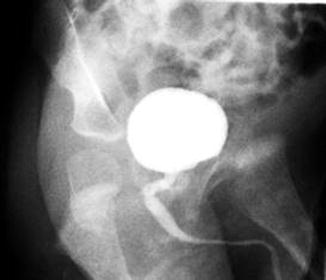

Fig. 6.10
VCUG showing a kink in the urethra suggesting the fistula location
6.4 Determination of the Fistula Location Prior to the Colostomy
6.4.1 Anatomic Facts and Timing
To understand the rationality of the imaging during the neonatal period to determine the location of the rectum and the fistula, it is extremely important for the clinician and the radiologist to understand the anatomy of the pelvis of babies with anorectal malformations, this is illustrated in Animation 6.1.
The sphincter mechanism in babies with anorectal malformations is represented by a wide spectrum that goes from almost normal striated sphincter mechanism to almost absent sphincters.
The sphincter mechanism in normal individuals is represented by a funnel-like voluntary muscle structure, the upper limits of that funnel being the pubococcygeal line (Fig. 6.11). That funnel-like muscle mechanism is a continuum of a striated muscle that runs all the way down to the skin of the perineum. The upper part of the funnel-like mechanism inserts in the pubic bone and surrounds the rectum. The contraction of those fibers compresses the rectum from behind. During surgical explorations, there is no way to identify separated portions of that muscle that has been referred to as “levator mechanism,” “puborectalis muscle,” “ischiococcygeal muscle,” “pubourethralis muscle”; one rather sees only a continuum of musculature.
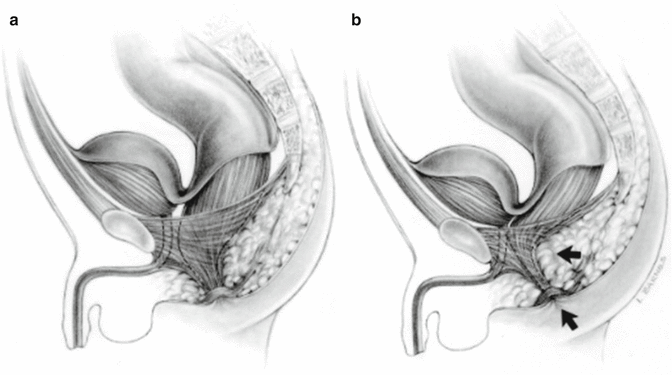

Fig. 6.11
Funnel-like normal sphincter mechanism. (a) Relaxed. (b) Contracted
In cases of anorectal malformations, the rectum is passing through this funnel-like muscle mechanism and stops at different heights. In cases of perineal fistulas, for example, most of the rectum is passing through this muscle mechanism and is only anteriorly deviated in the lowest portion (Fig. 6.12). In rectourethral fistulas, most of the rectum also passes through this funnel and ends into the upper part of the posterior urethra (prostatic fistula) or into the lowest portion of the posterior urethra (rectourethral bulbar fistula) (Fig. 6.13). In cases of recto-bladder neck fistula which represents the highest of all defects in male patients, the rectum opens in the bladder neck and is not surrounded by this sphincter mechanism (Fig. 6.14). Strictly speaking and using the old terminology, this particular defect is the only one that we can call “supralevator malformation.”

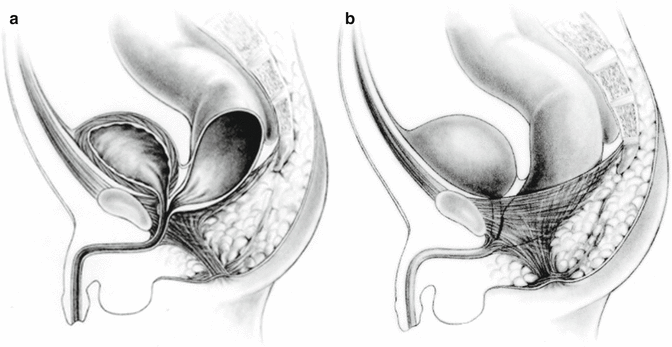
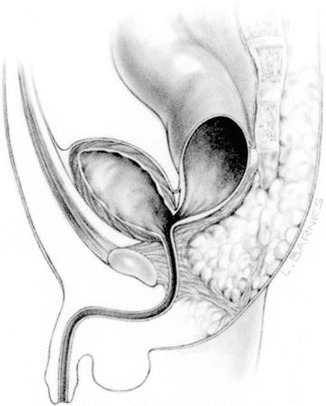

Fig. 6.12
Diagram of a perineal fistula. Most of the rectum is surrounded by the funnel-like sphincter mechanism

Fig. 6.13
Diagram showing a rectourethral fistula. (a) Prostatic. (b) Bulbar

Fig. 6.14
Diagram showing recto-bladder neck fistula. The bowel is not surrounded by sphincter muscle
The funnel muscle mechanism has, as expected, a muscle tone that keeps the rectum collapsed. This muscle only relaxes in normal individuals during the evacuation of feces. If one takes an abdominal x-ray film of a normal newborn with no anorectal malformation, it would be easy to see that the gas in the rectum stops at the level of the pubococcygeal line (which is the upper limit of the funnel-like sphincter mechanism). From there down to the skin, the rectum remains collapsed due to the tone of the muscle that surrounds it. In cases of anorectal malformations, if one takes an abdominal x-ray film during the first few hours of life, we will never find the gas of the rectum located below the pubococcygeal line and certainly that does not mean that the baby has a “very high malformation” since most likely (90 % chance), the rectum is located below the pubococcygeal line but is compressed by the sphincter mechanism. Interestingly, in our literature review, we only found one author [4] who suggested that the contraction of the “puborectalis muscle” must be taken into consideration to interpret radiologic studies in the newborn.
We are convinced that:
Diagnostic Imaging Studies performed during the first few hours of life are not reliable to determine the real location of the rectum
The diagnostic challenge during the newborn stage, in patients with anorectal malformations prior to the opening of a colostomy, is not related so much to the quality and sophistication of the imaging technology used, but rather to the knowledge of the anatomy and physiology of the rectum and the surrounding sphincter in patients with anorectal malformations during the first few hours of life. That is the reason why we recommend not doing diagnostic studies trying to determine the location of the rectum during the first 24 h of life. We have learned that babies with anorectal malformations usually are not born with abdominal distention. They rather become distended after 20 or 24 h of life. This abdominal distention represents, as expected, an increase of the intraluminal pressure of the bowel, and at some point, that pressure overcomes the muscle tone of the funnel mechanism that surrounds the rectum, and then one can see the real location of the gas inside the rectum (Fig. 6.15).
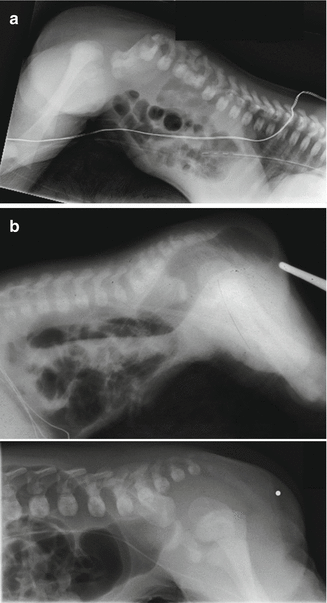

Fig. 6.15
Cross-table lateral film in a newborn baby with imperforate anus. (a) Six hours old. (b) Twenty-four hours old
We have been exposed to patients that are referred to us after failed attempted repairs. Some of those babies were subjected to diagnostic imaging studies during the first few hours of life that led the surgeons to erroneously conclude that the baby had a “high imperforate anus.” As a consequence, the surgeons made one of two decisions, either to open a colostomy (that was not indicated) or even worse, to perform an abdominoperineal procedure in a baby that had, for instance, an unnoticed perineal fistula. Some of those patients that had a non-indicated colostomy subsequently have received a distal colostogram without enough hydrostatic pressure, which induced the surgeons “to confirm” the diagnosis of “high imperforate anus.” Again, the distal colostogram was done without the necessary pressure to overcome the muscle tone of the funnel mechanism, and the surgeon made a wrong diagnosis.
6.5 The Old Invertogram
The famous prominent professor of surgery Dr. Wangesteen and Dr. Rice, a radiologist, published a seminal paper [5] that represents the beginning of the era of the radiologic evaluation of patients with anorectal malformations. The rationale behind that study was to put the newborn baby upside-down, to wait for a few minutes, and to assume that by gravity, the gas inside the bowel would reach the most distal part of the rectum. The gas would then act like a contrast, a simple lateral film of the pelvis with an anal marker was taken and the distance from the anal marker to the bubble of gas would allow the surgeon to classify the malformation into a “low malformation” (when the distance was shorter than 1 cm) or “high malformation” (when it was longer than one centimeter). Traditionally, the “low malformations” were surgically approached through the perineum and the “high malformations” were operated abdominoperineally. Now we know that when that kind of film is taken after 24 h, it certainly may show an image considered representative of the location of the rectum, but when the study is performed too early in life, it is not reliable.
Stay updated, free articles. Join our Telegram channel

Full access? Get Clinical Tree








